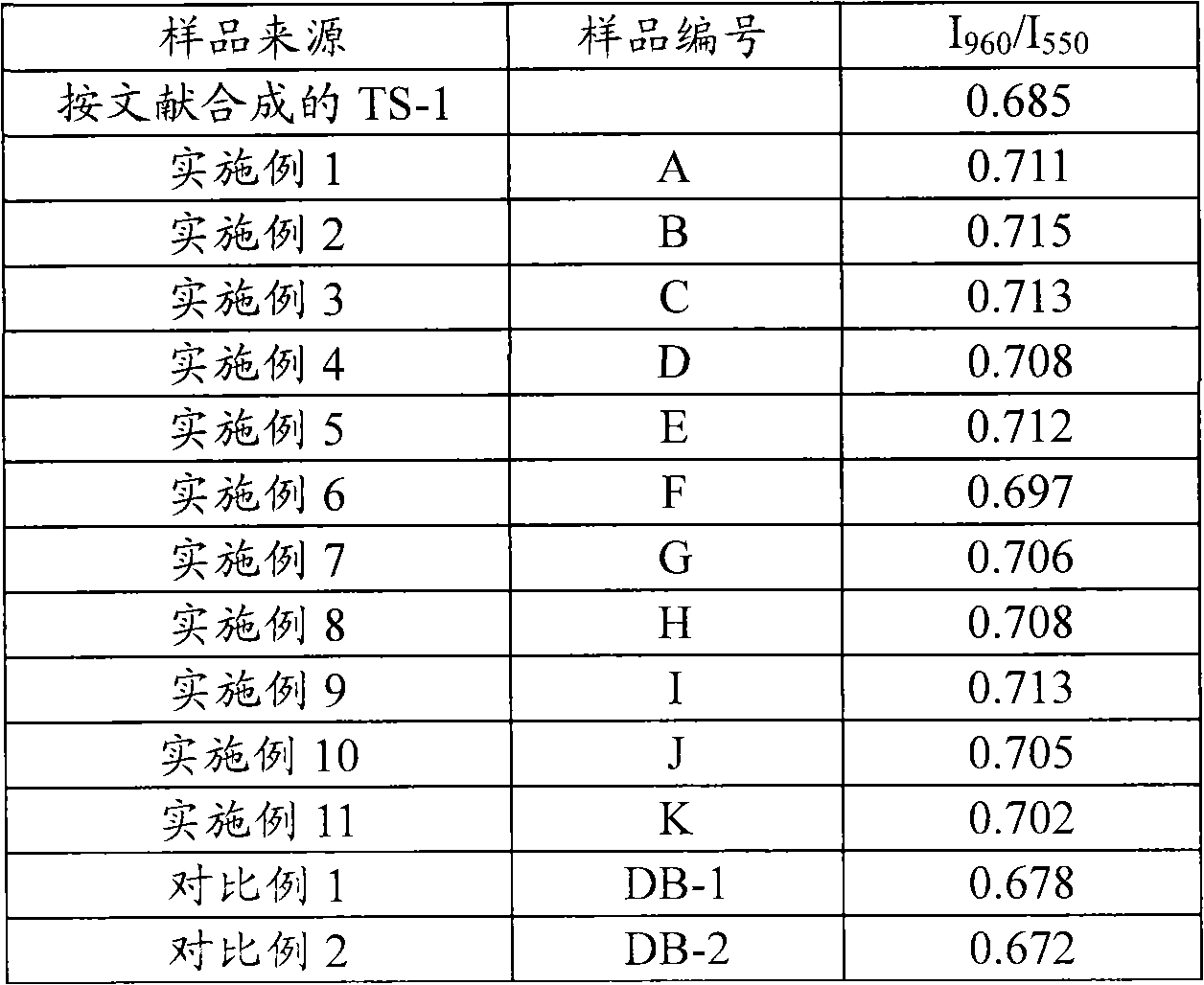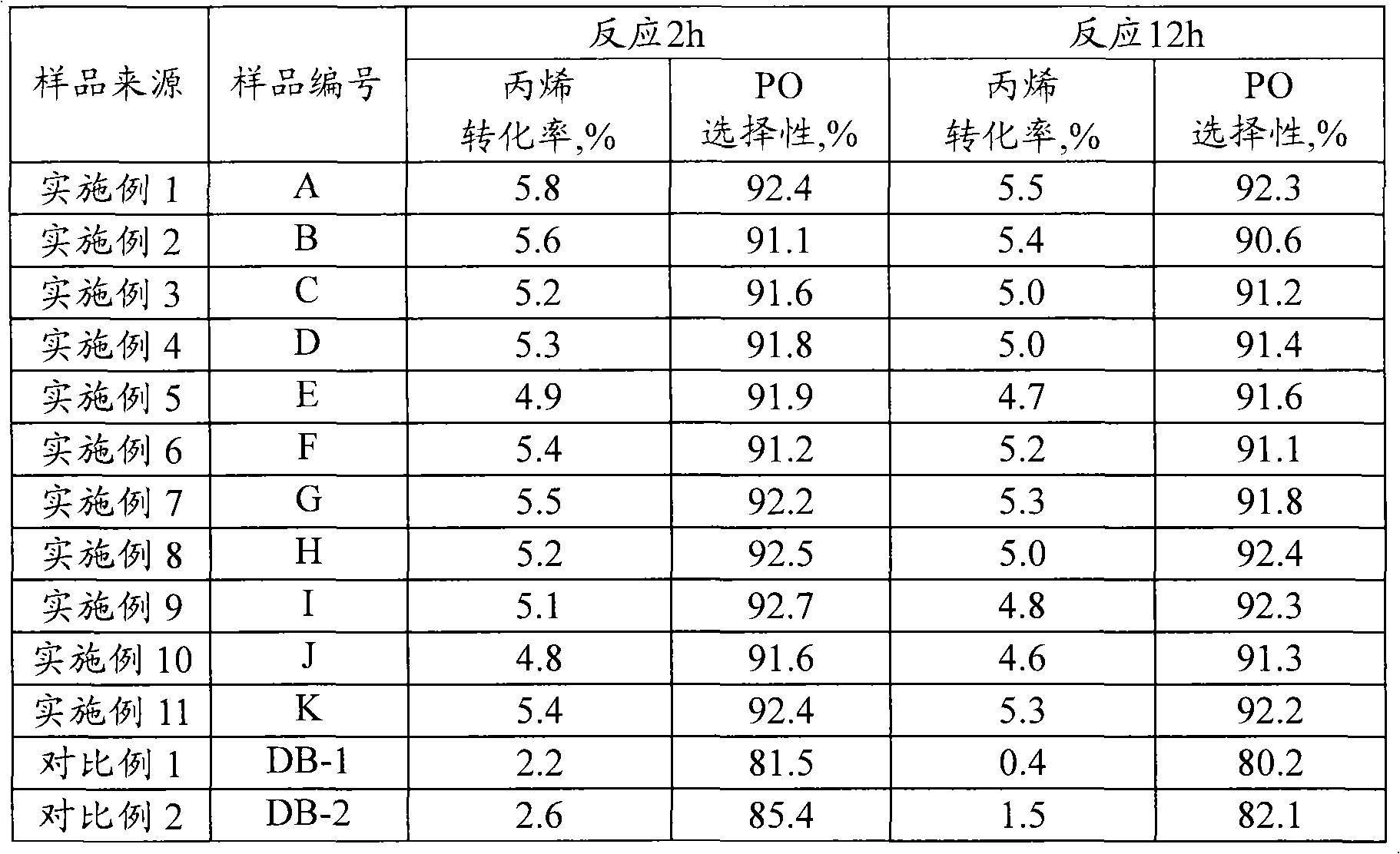Method for modifying titanium-silicon molecular sieve
A titanium-silicon molecular sieve and modification technology, used in molecular sieve catalysts, chemical instruments and methods, physical/chemical process catalysts, etc., can solve the problems of low effective utilization rate, poor stability, low catalyst activity, etc., and improve the total titanium content. , strong activity stability, the effect of increasing the relative amount of skeleton titanium
- Summary
- Abstract
- Description
- Claims
- Application Information
AI Technical Summary
Problems solved by technology
Method used
Image
Examples
Embodiment 1
[0033] Get 20 grams of titanium-silicon molecular sieves TS-1, the concentration of 0.01g / mL (in terms of palladium atoms) ammonium nitrate palladium complex solution and cetyltrimethylammonium bromide to join the tetrapropylammonium hydroxide Stir in an aqueous solution (mass percentage concentration 10%) to obtain a mixed solution 1, wherein titanium silicon molecular sieve (gram): hexadecyltrimethylammonium bromide (mole): tetrapropyl ammonium hydroxide (mole): ammonium nitrate Palladium complex (g, calculated as palladium): water (mol) = 100: 0.3: 0.005: 0.5: 1000. TiCl 4 , isopropanol, butylenediamine and water according to TiCl 4 (mol): isopropanol (mol): butylenediamine (mol): water (mol) = 1: 25: 5: 200 ratio was mixed at room temperature, stirred for 30 minutes to obtain mixed solution 2, and then mixed solution 1 and the mixed solution 2 are mixed according to the ratio of molecular sieve (g): Ti (mol) = 200: 1, then put into a stainless steel reactor and sealed, h...
Embodiment 2
[0035] Take 20 grams of titanium-silicon molecular sieve TS-1, palladium chloride solution and polyacrylate with a concentration of 0.01 g / mL (calculated as palladium atoms), and add them to an aqueous solution of sodium hydroxide (mass percentage concentration 15%) and stir evenly to obtain a mixed Liquid 1, wherein titanium-silicon molecular sieve (gram): polyacrylate (mol): sodium hydroxide (mol): palladium chloride (gram, calculated as palladium): water (mol) = 100: 0.9: 1.0: 0.15: 1600 . Ti(SO 4 ) 2 , isopropanol, tetrapropylammonium hydroxide and water according to Ti(SO 4 ) 2 (mol): isopropanol (mol): tetrapropyl ammonium hydroxide (mol): water (mol)=1: 5: 8: 100 ratio mixes, stirs 60 minutes, gets mixed solution 2, then mixed solution 1 and the mixed solution 2 are mixed according to the ratio of molecular sieve (g): Ti (mol) = 500: 1, then put into a stainless steel reaction kettle, seal, hydrothermally treat at a temperature of 180° C. and autogenous pressure for...
Embodiment 3
[0037] Get 20 grams of titanium silicon molecular sieve TS-1, concentration is the palladium nitrate solution of 0.01g / mL (as palladium atom) and Tween 80 and joins the aqueous solution (mass percentage concentration 10% of tetrapropyl ammonium hydroxide and butanediamine) ) and stirred uniformly to obtain mixed solution 1, wherein titanium silicon molecular sieve (gram): protective agent (mol): organic amine (mol): palladium source (gram, calculated as palladium): water (mol) = 100: 0.03: 0.1: 0.05:550; TiOCl at room temperature 2 , butylenediamine and water according to TiOCl 2 (mol): butyldiamine (mol): water (mol) = 1: 2: 50 ratio mixed, stirred for 15 minutes to obtain mixed solution 2, then mixed solution 1 and mixed solution 2 according to molecular sieve (gram): Ti( mol) = 800:1 ratio, put into stainless steel reactor, seal, hydrothermal treatment at 120°C temperature and autogenous pressure for 120h, filter, wash, and then dry at 150°C for 3h, in a nitrogen atmospher...
PUM
 Login to View More
Login to View More Abstract
Description
Claims
Application Information
 Login to View More
Login to View More - R&D
- Intellectual Property
- Life Sciences
- Materials
- Tech Scout
- Unparalleled Data Quality
- Higher Quality Content
- 60% Fewer Hallucinations
Browse by: Latest US Patents, China's latest patents, Technical Efficacy Thesaurus, Application Domain, Technology Topic, Popular Technical Reports.
© 2025 PatSnap. All rights reserved.Legal|Privacy policy|Modern Slavery Act Transparency Statement|Sitemap|About US| Contact US: help@patsnap.com


